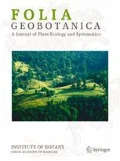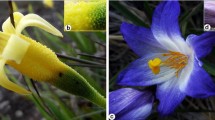Abstract
The composition of volatile oils produced byEuphorbia fragifera is reported. The plant samples were collected in two different habitats on the Karst plateau North of Trieste (North Eastern Italy). The analysis was performed by capillary GC. Differences between samples from the two habitats have been found in the quantitative composition of the oils. The plants coming from the optimal, xeric habitat produce oils in which aromatic terpenes (mostly carvacrol) are more abundant, whereas the oils of plants growing in shady and moist sites are mostly composed by acyclic compounds (chiefly geraniol). It seems therefore possible to distinguish two chemical variants ofEuphorbia fragifera. The number and kind of pollinating insects have been recorded. Terpenoids from the two kinds of essential oil could be responsible of two different pheromones that attract different kinds of pollinators.
Similar content being viewed by others
Literature cited
Ahmad S., Seligmann O. etHussain G. (1977): Caudicifolin, a new diterpene fromE. caudicifolia.—Phytochem. 16: 1844.
Coassini Lokar L., Maurich V. etPoldini L. (1983): Indagine fitochimica comparativa dellolio essenziale diSatureja variegata Host e della congenereS. subspicata Vis.—Webbia 37 (1): 000-000.
Coassini Lokar L., Maurich V. etPoldini L. (1986): Variation in terpene composition ofArtemisic alba (Compositae) in relation with environmental conditions.—Biochem. System. Ecol. (in press).
Dodson C. H., Dressler R. L., Hills H. G., Adams R. M. etWilliams N. H. (1969): Biologically active compounds in orchid fragrances.—Science; 164: 1243–1249.
Evans F. J. (1977): A new phorbol triesther from the latices ofE. frankiana andE. coerulescens.— Phytochem., 16: 395–396.
Faegri K. etvan der Pijl L. (1979): Principles of pollination ecology.—3rd rev., ed. Pergamon Press, Oxford.
Feoli E., Lagonegro M. etOrloci L. (1984): Information analysis of vegetation data.— In: H. Lieth et H. Mooney (eds.): Tasks for Vegetation Science. Junk. The Hague, Boston
Fornasiero V., Guiotto A., Caporale G., Baccichetti F. etMusajo L. (1969): Identificazione della sostanza attrattiva per i maschi dellaCeratitia capitata, contenuta nell'olio essenziale dei semi diAngelica archangelica.—Gazz. Chim. Ital., 99: 700–710
Gershenzon J., Lincoln D. E. etLanghenheim J. H. (1978): The effect of molsture stress on monoterpenoid yield and composition inSatureja douglassii.—Bioch. System. and Ecol., 6: 33–43
Kinghorn A. D. etEvans F. J. (1975): Isolation of phorbol fromE. franckiana.—Phytochem., 14: 585–586
Lausi D. etPoldini L. (1962): I1 paesaggio vegetale della costiera triestina.—Boll. Soc. Adr. Scienze, Trieste, Italia, LII: 1–63
Lincoln D. E. etLangenheim J. H. (1978): Effect of light and temperature on monoterpenoid yield and composition inSatureja douglassi.—Biochem. System. and Ecol., 6: 21–32
Lincoln D. E. etLangenheim J. H. (1979): Variation ofSatureja douglasii monoterpenoids in relation to light intensity and herbiovory.—Bioch. System. and Ecol., 7: 289–298
Nielsen P. E., Nishimura H., Liang Y. etCalvin M. (1979): Steroids fromEuphorbia and other latex-bearing plants.—Phytochem., 18: 2217.
Poldini L. etStancher B. (1969): Gli oli essenziali diSatureja variegata Host (=S. montana auct. pl. non L.) nel Carso triestino.—Giorn. Bot. Ital., 103: 65–77
Rodriguez E., Towers G. H. N. etMitchell J. C. (1976): Biological activities of sesquiterpene lactones.—Phytochem., 15: 1573–1779
Rudinski J. A. (1966): Scotytid beetles associated with Douglas Fir: response to terpenes.— Science, 152: 218–219
Schmidt R. J. etEvans F. J. (1976): A new aromatic ester diterpene fromEuphorbia poisonii.—Phytochem., 15: 1778–1779
Upadhyay R. R. etHecker E. (1975): Diterpene esters of the irritant and cocarcinogenic latex ofEuphorbia lactea.—Phytochem., 14: 2514–2515
Author information
Authors and Affiliations
Rights and permissions
About this article
Cite this article
Lokar, L.C., Maurich, V. & Poldini, L. Chemical aspect of floral biology inEuphorbia fragifera . Folia geobot. phytotax. 21, 277–285 (1986). https://doi.org/10.1007/BF02853259
Received:
Issue Date:
DOI: https://doi.org/10.1007/BF02853259



